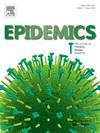Quantifying the impact of prevalence-dependent adaptive behavior on COVID-19 transmission: A modeling case study in Maryland
IF 2.4
3区 医学
Q2 INFECTIOUS DISEASES
引用次数: 0
Abstract
The COVID-19 pandemic highlighted the need for robust epidemic forecasts, projecting health burden over short- and medium-term time horizons. Many COVID-19 forecasting models incorporate information on infection transmission, disease progression, and the effects of interventions, but few combine information on how individuals change their behavior based on altruism, fear, risk perception, or personal economic circumstances. Moreover, early models of COVID-19 produced under- and over-estimates, failing to consider the complexity of human responses to disease threat and prevention measures. In this study, we modeled adaptive behavior during the first year of the COVID-19 pandemic in Maryland, USA. The adapted compartmental model incorporates time-varying transmissibility informed on data of environmental factors (e.g., absolute humidity) and behavioral factors (aggregate mobility and perceived risk). We show that humidity and mobility alone did little to explain transmissibility after the first 100 days. Including adaptive behavior in the form of perceived risk as a function of hospitalizations more effectively explained inferred transmissibility and improved out-of-sample fit, demonstrating the model’s potential in real-time forecasting. These results demonstrate the importance of incorporating endogenous behavior in models, particularly during a pandemic, to produce more accurate projections, which could lead to more impactful and efficient decision making and resource allocation.
量化流行依赖性适应行为对 COVID-19 传播的影响:马里兰州的模型案例研究
COVID-19 大流行突显了对强有力的流行病预测的需求,预测中短期的健康负担。许多 COVID-19 预测模型都包含了有关感染传播、疾病进展和干预效果的信息,但很少有模型结合了有关个人如何因利他主义、恐惧、风险意识或个人经济状况而改变其行为的信息。此外,早期的 COVID-19 模型产生了过低或过高的估计值,没有考虑到人类对疾病威胁和预防措施反应的复杂性。在本研究中,我们对美国马里兰州 COVID-19 大流行第一年的适应行为进行了建模。经过改编的分区模型结合了环境因素(如绝对湿度)和行为因素(总流动性和感知风险)的时变传播性数据。我们的研究表明,在最初的 100 天之后,仅凭湿度和流动性几乎无法解释传播性。将作为住院函数的感知风险形式的适应性行为纳入其中,可以更有效地解释推断的传播性,并提高样本外拟合度,证明了该模型在实时预测方面的潜力。这些结果表明了在模型中加入内生行为的重要性,尤其是在大流行期间,这样可以产生更准确的预测,从而做出更有影响力和更有效的决策并分配资源。
本文章由计算机程序翻译,如有差异,请以英文原文为准。
求助全文
约1分钟内获得全文
求助全文
来源期刊

Epidemics
INFECTIOUS DISEASES-
CiteScore
6.00
自引率
7.90%
发文量
92
审稿时长
140 days
期刊介绍:
Epidemics publishes papers on infectious disease dynamics in the broadest sense. Its scope covers both within-host dynamics of infectious agents and dynamics at the population level, particularly the interaction between the two. Areas of emphasis include: spread, transmission, persistence, implications and population dynamics of infectious diseases; population and public health as well as policy aspects of control and prevention; dynamics at the individual level; interaction with the environment, ecology and evolution of infectious diseases, as well as population genetics of infectious agents.
 求助内容:
求助内容: 应助结果提醒方式:
应助结果提醒方式:


